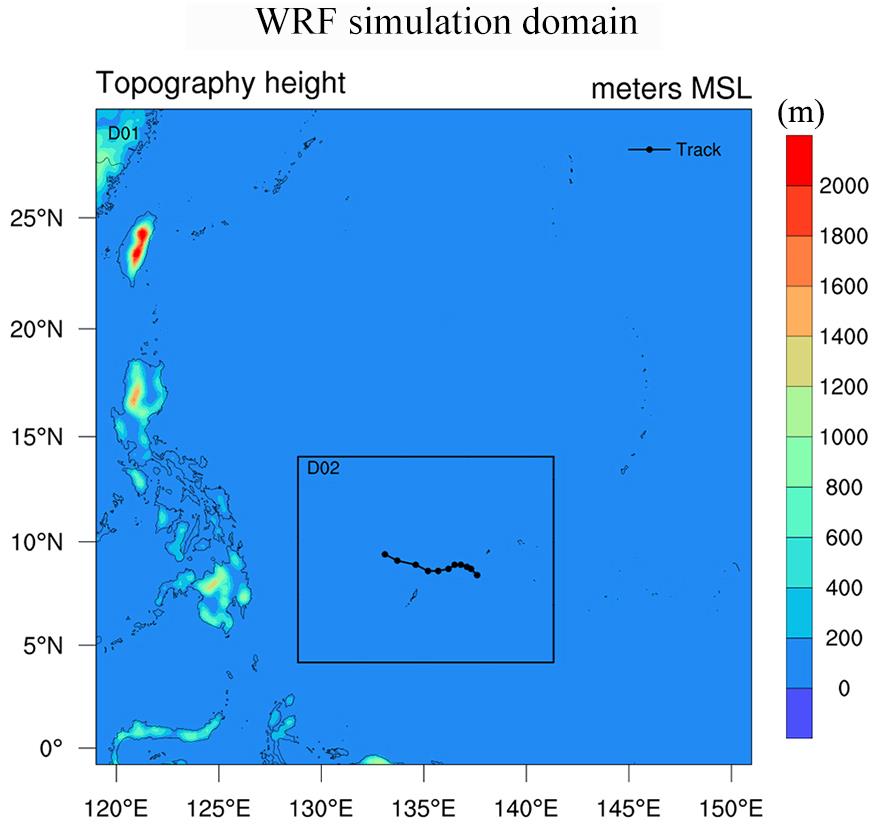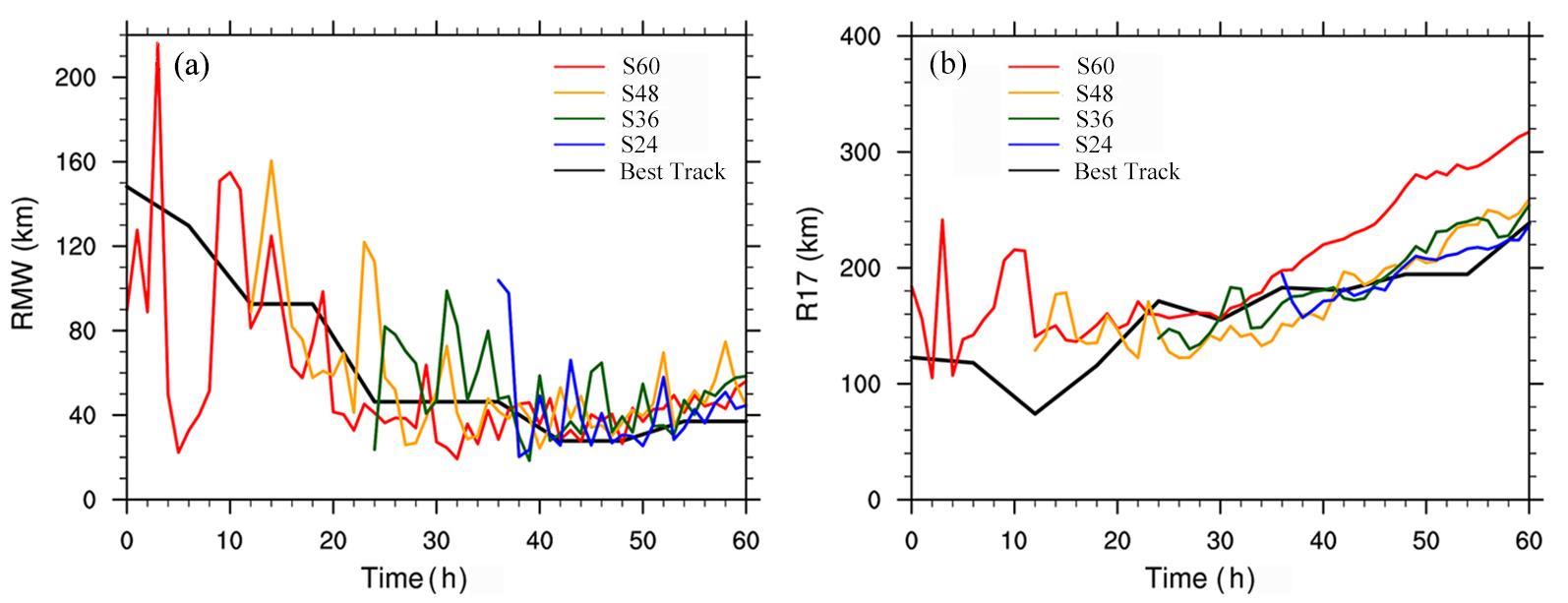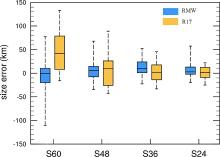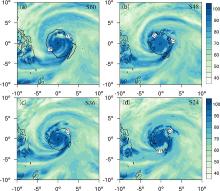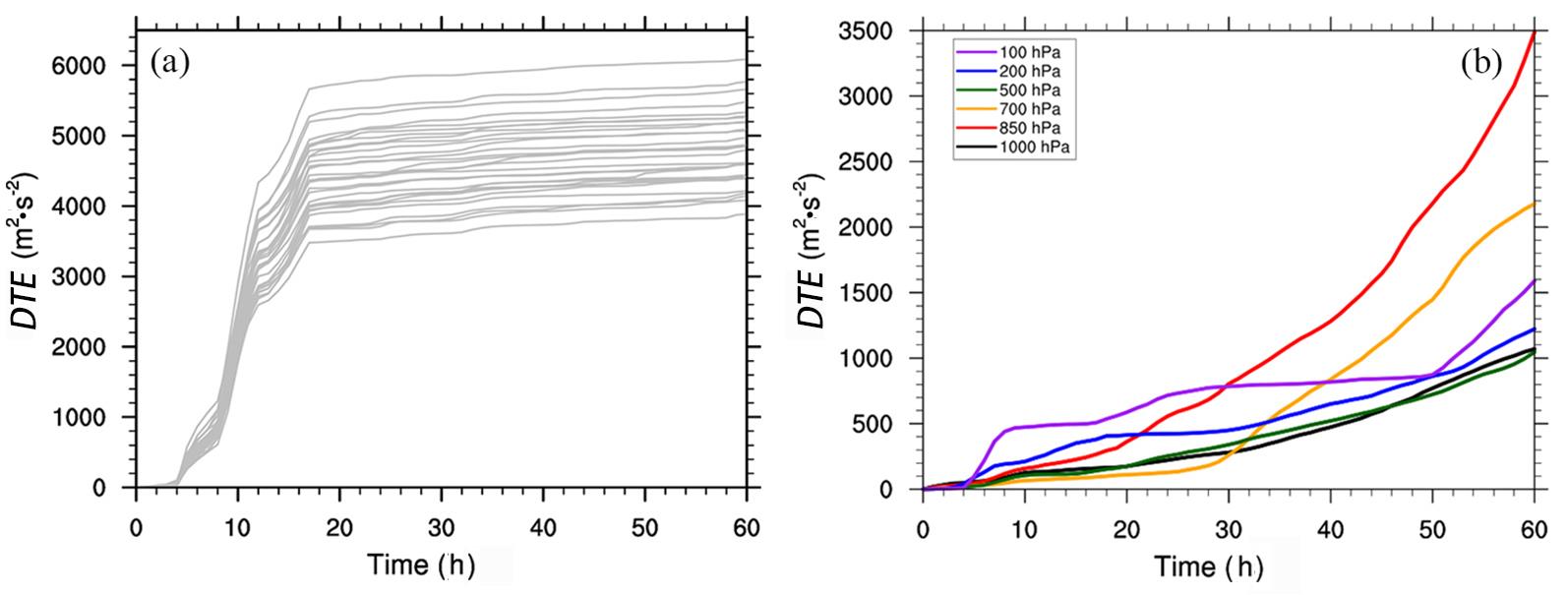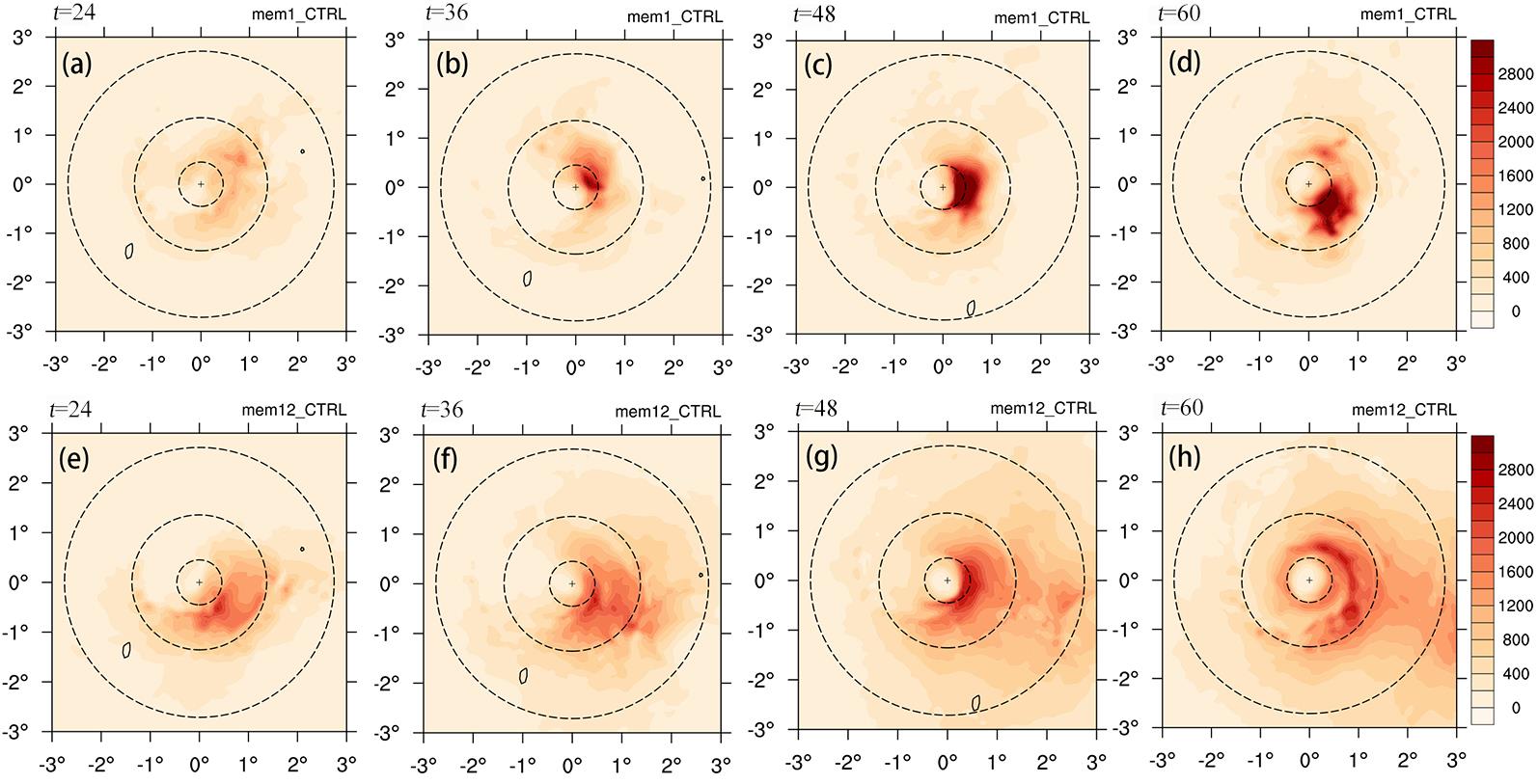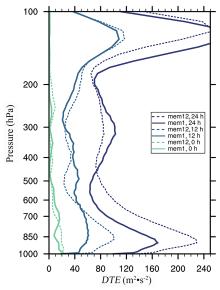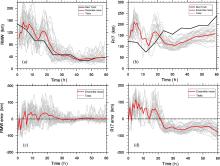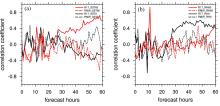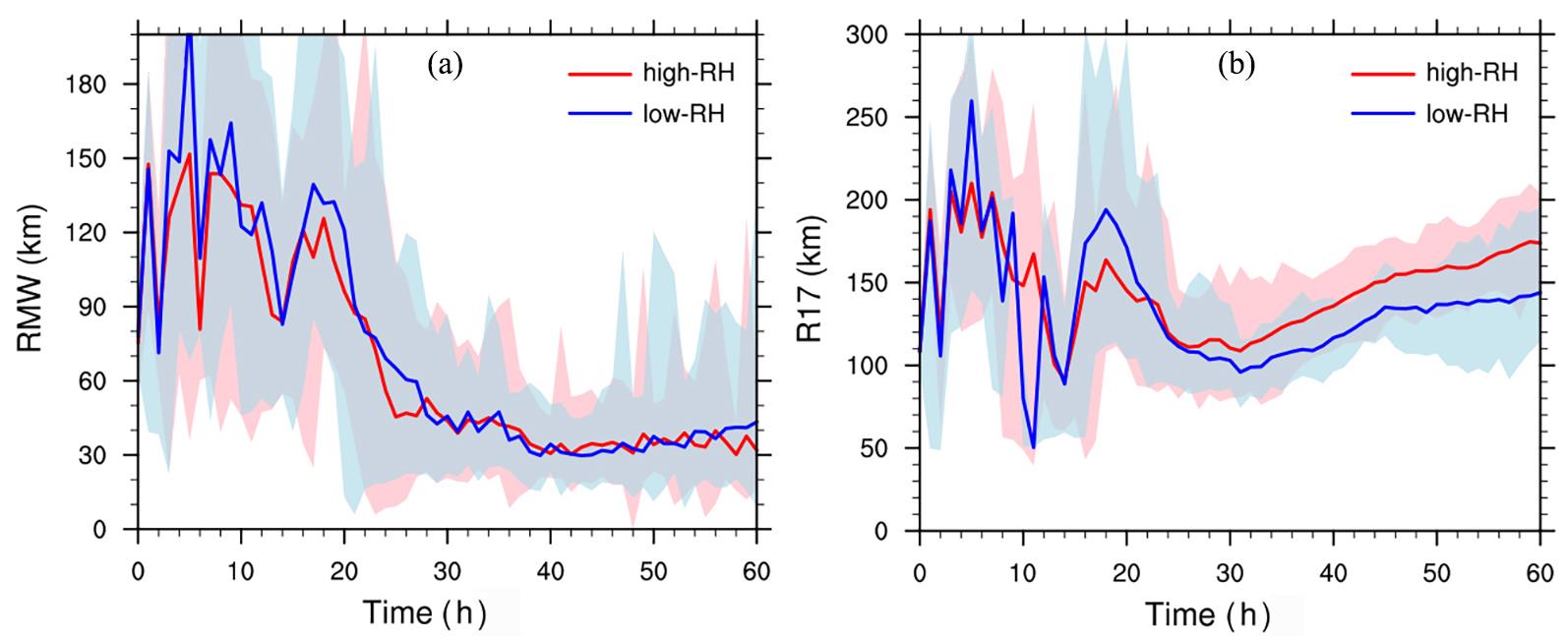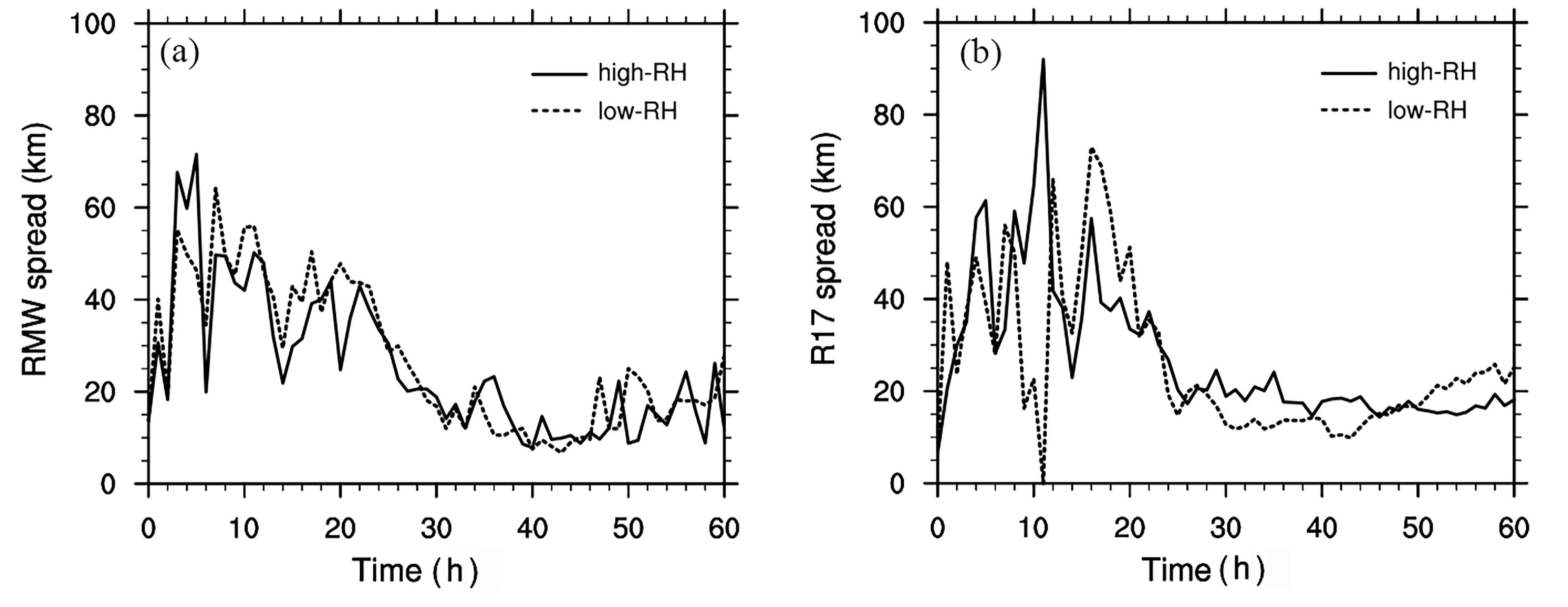南京大学学报(自然科学版) ›› 2024, Vol. 60 ›› Issue (2): 218–229.doi: 10.13232/j.cnki.jnju.2024.02.004
• • 上一篇
超强台风“舒力基”(2021)的尺度可预报性
- 中尺度灾害性天气教育部重点实验室,南京大学大气科学学院,南京,210023
On the size predictability of Super Typhoon Surigae (2021)
- Key Laboratory of Mesoscale Severe Weather, Ministry of Education, and School of Atmospheric Sciences,Nanjing University,Nanjing, 210023,China
摘要:
台风尺度表征了台风低层风场特定风速半径大小,是台风灾害影响范围的重要度量.针对超强台风“舒力基”(2021),对其尺度可预报性进行初步探讨.结果表明,模式可以模拟出台风发展初期台风尺度(内核尺度RMW、外围尺度R17)的演变趋势.基于集合预报的模拟试验,具体分析了内核尺度RMW、外围尺度R17演变及其误差增长特征.台风预报总体误差主要出现在对流层下层850 hPa,距离台风中心50~150 km.从初始环境场看,初始相对湿度是影响台风尺度误差增长的重要因子,初始高湿环境有利于台风发展阶段的台风尺度高离散度,从而限制了台风尺度的可预报性.在一定程度上,外围风圈半径的可预报性要高于内核风圈半径.
中图分类号:
- P444
| 1 | Rotunno R, Emanuel K A. An air–sea interaction theory for tropical cyclones. Part Ⅱ:Evolutionary study using a nonhydrostatic axisymmetric numerical model. Journal of the Atmospheric Sciences,1987,44(3):542-561. |
| 2 | Cocks S B, Gray W M. Variability of the outer wind profiles of western North Pacific typhoons:Classifications and techniques for analysis and forecasting. Monthly Weather Review,2002,130(8):1989-2005. |
| 3 | Lee C S, Cheung K K W, Fang W T,et al. Initial maintenance of tropical cyclone size in the western North Pacific. Monthly Weather Review,2010,138(8):3207-3223. |
| 4 | Xu J, Wang Y Q. Sensitivity of the simulated tropical cyclone inner?core size to the initial vortex size. Monthly Weather Review,2010,138(11):4135-4157. |
| 5 | Ying Y, Zhang Q H. A modeling study on tropical cyclone structural changes in response to ambient moisture variations. Journal of the Meteorological Society of Japan. Ser. Ⅱ,2012,90(5):755-770. |
| 6 | Lin Y L, Zhao M, Zhang M H. Tropical cyclone rainfall area controlled by relative sea surface temperature. Nature Communications,2015,6:6591. |
| 7 | Emanuel K A, Neelin J D, Bretherton C S. On large-scale circulations in convecting atmospheres. Quarterly Journal of the Royal Meteorological Society,1994,120(519):1111-1143. |
| 8 | Hill K A, Lackmann G M. Influence of environmental humidity on tropical cyclone size. Monthly Weather Review,2009,137(10):3294-3315. |
| 9 | Wang Y Q. How do outer spiral rainbands affect tropical cyclone structure and intensity?. Journal of the Atmospheric Sciences,2009,66(5):1250-1273. |
| 10 | Tang X D, Tan Z M, Fang J,et al. Impact of the diurnal radiation contrast on the contraction of radius of maximum wind during intensification of Hurricane Edouard (2014). Journal of the Atmospheric Sciences,2019,76(2):421-432. |
| 11 | Zhao C F, Lin Y L, Wu F,et al. Enlarging rainfall area of tropical cyclones by atmospheric aerosols. Geophysical Research Letters,2018,45(16):8604-8611. |
| 12 | Jones S C, Harr P A, Abraham J,et al. The extratropical transition of tropical cyclones:Forecast challenges,current understanding,and future directions. Weather and Forecasting,2003,18(6):1052-1092. |
| 13 | Pérez?Alarcón A,SoríR, Fernández?Alvarez J C,et al. Comparative climatology of outer tropical cyclone size using radial wind profiles. Weather and Climate Extremes,2021,33:100366. |
| 14 | Knaff J A, Longmore S P, Molenar D A. An objective satellite?based tropical cyclone size climatology. Journal of Climate,2014,27(1):455-476. |
| 15 | Carr III L E, Elsberry R L. Models of tropical cyclone wind distribution and beta?effect propagation for application to tropical cyclone track forecasting. Monthly Weather Review,1997,125(12):3190-3209. |
| 16 | Weatherford C L, Gray W M. Typhoon structure as revealed by aircraft reconnaissance. Part Ⅰ:Data analysis and climatology. Monthly Weather Review,1988,116(5):1032-1043. |
| 17 | Chavas D R, Emanuel K. Equilibrium tropical cyclone size in an idealized state of axisymmetric radiative–convective equilibrium. Journal of the Atmospheric Sciences,2014,71(5):1663-1680. |
| 18 | Khairoutdinov M, Emanuel K. Rotating radiative?convective equilibrium simulated by a cloud?resolving model. Journal of Advances in Modeling Earth Systems,2013,5(4):816-825. |
| 19 | Chavas D R, Lin N, Dong W H,et al. Observed tropical cyclone size revisited. Journal of Climate,2016,29(8):2923-2939. |
| 20 | Chen B F, Davis C A, Kuo Y H. An idealized numerical study of shear?relative low?level mean flow on tropical cyclone intensity and size. Journal of the Atmospheric Sciences,2019,76(8):2309-2334. |
| 21 | 向纯怡,吴立广,田伟,等. 多平台热带气旋表面风场资料在台风结构分析中的应用. 气象,2016,42(11):1315-1324. |
| Xiang C Y, Wu L G, Tian W,et al. Applications of MTCSWA data to the characteristic analysis of tropical cyclone structure. Meteorological Monthly,2016,42(11):1315-1324. | |
| 22 | Zhuo J Y, Tan Z M. Physics?augmented deep learning to improve tropical cyclone intensity and size estimation from satellite imagery. Monthly Weather Review,2021,149(7):2097-2113. |
| 23 | Skamarock W C, Klemp J B. A time?split nonhydrostatic atmospheric model for weather research and forecasting applications. Journal of Computational Physics,2008,227(7):3465-3485. |
| 24 | Kain J S, Fritsch J M. A one?dimensional entraining detraining plume model and its application in convective parameterization. Journal of the Atmospheric Sciences,1990,47(23):2784-2802. |
| 25 | Lin Y L, Farley R D, Orville H D. Bulk parameterization of the snow field in a cloud model. Journal of Applied Meteorology,1983,22(6):1065-1092. |
| 26 | Hong S Y, Noh Y, Dudhia J. A new vertical diffusion package with an explicit treatment of entrainment processes. Monthly Weather Review,2006,134(9):2318-2341. |
| 27 | Dudhia J. A multi?layer soil temperature model for MM5∥The 6th Annual PSU/NCAR Mesoscale Model Users' Workshop. Boulder,CO,USA:NCAR,1996:49-50. |
| 28 | Mlawer E J, Taubman S J, Brown P D,et al. Radiative transfer for inhomogeneous atmospheres:RRTM,a validated correlated?k model for the longwave. Journal of Geophysical Research:Atmospheres,1997,102(D14):16663-16682. |
| 29 | Dudhia J. Numerical study of convection observed during the winter monsoon experiment using a mesoscale two?dimensional model. Journal of Atmospheric Sciences,1989,46(20):3077-3107. |
| 30 | Melhauser C, Zhang F Q. Practical and intrinsic predictability of severe and convective weather at the mesoscales. Journal of the Atmospheric Sciences,2012,69(11):3350-3371. |
| 31 | Mitchell H L, Houtekamer P L, Pellerin G. Ensemble size,balance,and model?error representation in an Ensemble Kalman Filter. Monthly Weather Review,2002,130(11):2791-2808. |
| 32 | Zhang F Q, Meng Z Y, Aksoy A. Tests of an ensemble Kalman filter for mesoscale and regional?scale data assimilation. Part Ⅰ:Perfect model experiments. Monthly Weather Review,2006,134(2):722-736. |
| 33 | Li D Y, Tan Z M. The Role of ocean–atmosphere interactions in tropical cyclone intensity predictability. Journal of the Atmospheric Sciences,2023,80(5):1213-1226. |
| 34 | Guo X, Tan Z M. Tropical cyclone fullness:A new concept for interpreting storm intensity. Geophysical Research Letters,2017,44(9):4324-4331. |
| 35 | Wang D Y, Lin Y L. Size and structure of dry and moist reversible tropical cyclones. Journal of the Atmospheric Sciences,2020,77(6):2091-2114. |
| [1] | 张心怡, 张熠, 刘昊炎, 王其伟, 王迪. 模拟启动时间和双台风对“21.7”河南极端暴雨事件的影响研究[J]. 南京大学学报(自然科学版), 2024, 60(2): 194-208. |
| [2] | 李明珊, 王元兵, 王元. 台风“罗莎”影响东北冷涡强降水的机理研究[J]. 南京大学学报(自然科学版), 2022, 58(5): 741-749. |
| [3] | 蔡菊珍, 徐集云, 邵鑫, 彭珍, 张宁, 张育慧, 何月. 利奇马台风风场与湍流特征分析[J]. 南京大学学报(自然科学版), 2021, 57(5): 896-903. |
| [4] | 张璐,张熠,周博闻. 水平湍流混合对莫拉克(2009)台风强度及结构的影响[J]. 南京大学学报(自然科学版), 2020, 56(5): 616-629. |
| [5] | 韩峰,储可宽,张熠,刘昊炎. 西北太平洋双台风引导气流的伴随敏感性分析[J]. 南京大学学报(自然科学版), 2020, 56(5): 630-639. |
| [6] | 卓立,吴钲,方德贤,方娟. 超强台风“鲇鱼”形成过程中的水汽演变特征[J]. 南京大学学报(自然科学版), 2020, 56(5): 640-652. |
| [7] | 黄旋旋1,2,朱科锋1*,赵坤. 近海台风中心自适应定位方法研究[J]. 南京大学学报(自然科学版), 2014, 50(6): 855-864. |
| [8] | 王娜1,陈星1,程寿全2. 广州增城台风降水相关天气型[J]. 南京大学学报(自然科学版), 2014, 50(6): 847-854. |
| [9] | 罗 锋1,2*,盛建明1,2,潘锡山1,2,刘秋兴3. 江苏沿海精细化风暴潮模式研究与应用[J]. 南京大学学报(自然科学版), 2014, 50(5): 687-694. |
| [10] | 禹梁玉,方娟**. 台风随"鲇鱼”(2010)过程影响系统分析*[J]. 南京大学学报(自然科学版), 2013, 49(3): 285-299. |
| [11] | 张兴海1·2,郁凡1**. 台风强度及演变的卫星反演试验研究*[J]. 南京大学学报(自然科学版), 2012, 48(6): 701-708. |
| [12] | 杨蜀都,方 娟**. 台风Sinlaku ( 2008)生成过程环境场分析* [J]. 南京大学学报(自然科学版), 2011, 47(6): 659-669. |
| [13] | 聂高臻, 谈哲敏** , 仇欣 . 台风? 云娜?(2004)的数值模拟:眼墙对流与环境风切变的关系 * [J]. 南京大学学报(自然科学版), 2010, 46(3): 317-327. |
|
||





